The
Concrete Construction of the Roman Harbours of Baiae and Portus Iulius:
The
ROMACONS 2006 field season
C.
Brandon, R.L. Hohlfelder, J.P. Oleson
(submitted
to International Journal of Nautical Archaeology 20 April 2008)
Fix font
problem in footnotes.
Roman Hydraulic Concrete
The development by the Romans of hydraulic concrete for use in coastal underwater structures probably originated somewhere in the vicinity of Baiae (modern Baia) and Puteoli (modern Pozzuoli) at some time before the last quarter the 2nd century B.C. (Oleson et al., 2004: 199-203). The earliest surviving hydraulic concrete is found in the harbour pilae at Cosa, dated between the late 2nd century and the mid 1st century B.C (Gazda, 1987: 155 n.84; 2001:163; Oleson et al., 2004: 202; Gazda, 2008; McCann, 2008). Roman hydraulic concrete consists of large irregular stone or tuff aggregate set into a mortar of lime and sand-like volcanic ash rich in chemically reactive aluminosilicates. The bibliography on Roman hydraulic concrete is extensive, with most relevant published works listed by Gazda (2001: 171-77) and Oleson et al. (2004: 228-29, 2006: 51-2). The main ancient literary source that refers to concrete and its use in maritime structures is Vitruvius, De Architectura (2.6.1, 5.12.2-3), but there is a scatter of useful shorter comments in Strabo, Pliny, and Dionysios of Halikarnassos (see Oleson et al. 2004: 199-203; 2006: 33-4). By direct attribution, or through the implications of the term pulvis puteolanus (“powder from Puteoli”), Strabo (Geography 5.4.6), Vitruvius (On Architecture 5.12.2), Seneca (Questions about Nature 3.20.3), and Pliny (Natural History 16.202, 35.166) specifically identify the area around Puteoli (modern Pozzuoli), the modern Campi Flegrei at the north end of the Bay of Naples, as the source of the volcanic ash. (Figure 1: Campi Flegrei).
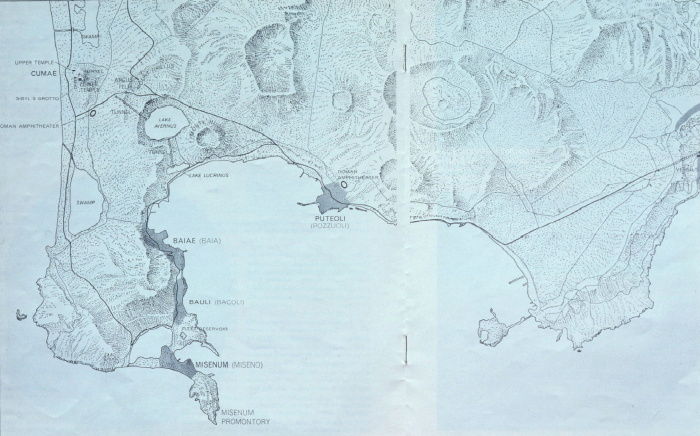
The modern term is “pozzolana,” which in the
strict sense should be applied only to ash from this region (see Jackson et
al. 2007). The modern term for the
resulting concrete is “hydraulic concrete.” In antiquity, this material was
used extensively in coastal defences (protective breakwaters), harbour
structures, and fish farms. Unless disturbed by modern shoreline developments,
these structures can be very well preserved despite the sometimes harsh
environment.
Although none of
the early, pioneering structures built of hydraulic concrete in the sea in the
Gulf of Pozzuoli (ancient Baianus Sinus)
seem to have survived, this remains an important area for the study Roman
hydraulic concrete in maritime structures. By the early first century B.C. this
region attracted affluent Roman aristocrats, including members of the imperial
household, who constructed villea maritimae on the shore and piscinae in the sea (D’Arms 1970). During the last decades of
the Republic and throughout the imperial period several major military harbours
were established, which involved extensive building projects in the sea
(Frederiksen, 1959; Scognamiglio, 2006; Miniero 2007).
The ROMACONS Project
ROMACONS, the
Roman Maritime Concrete Study, was established in 2001 to study the development
and application of Roman concrete in maritime settings. The project
investigates the make-up of the material, its physical properties, and the
nature of its placement. Standard core drilling procedures were adopted in
order to take intact stratigraphic samples (0.09 m in diameter and up to 5.8 m
long) that are then analyzed in the laboratories of Italcementi with a
comprehensive set of physical, mechanical and chemical protocols (see Oleson et
al. 2004: 208-10; 2006: 47-9). Since
fieldwork began in 2002, the team has recovered cores at Portus, Anzio, Cosa,
Santa Liberata, and Brindisi in Italy, at the harbour of Caesarea in Israel, at
the eastern harbour of Alexandria in Egypt, and at the harbour of Chersonesos
in Crete. The five cores we recovered in September 2006 from the harbour of
Baiae (modern Baia) and from Portus Iulius in the Gulf of Pozzuoli are the
subject of this article.
Along with precise definition of the engineering characteristics of Roman hydraulic concrete, our fieldwork has confirmed that the Roman engineers considered pozzolana from the Campi Flegrei as the optimal ingredient for hydraulic concrete in maritime structures both in Italy and elsewhere in the Mediterranean. (Figure 2: pozzolana from Bacoli)
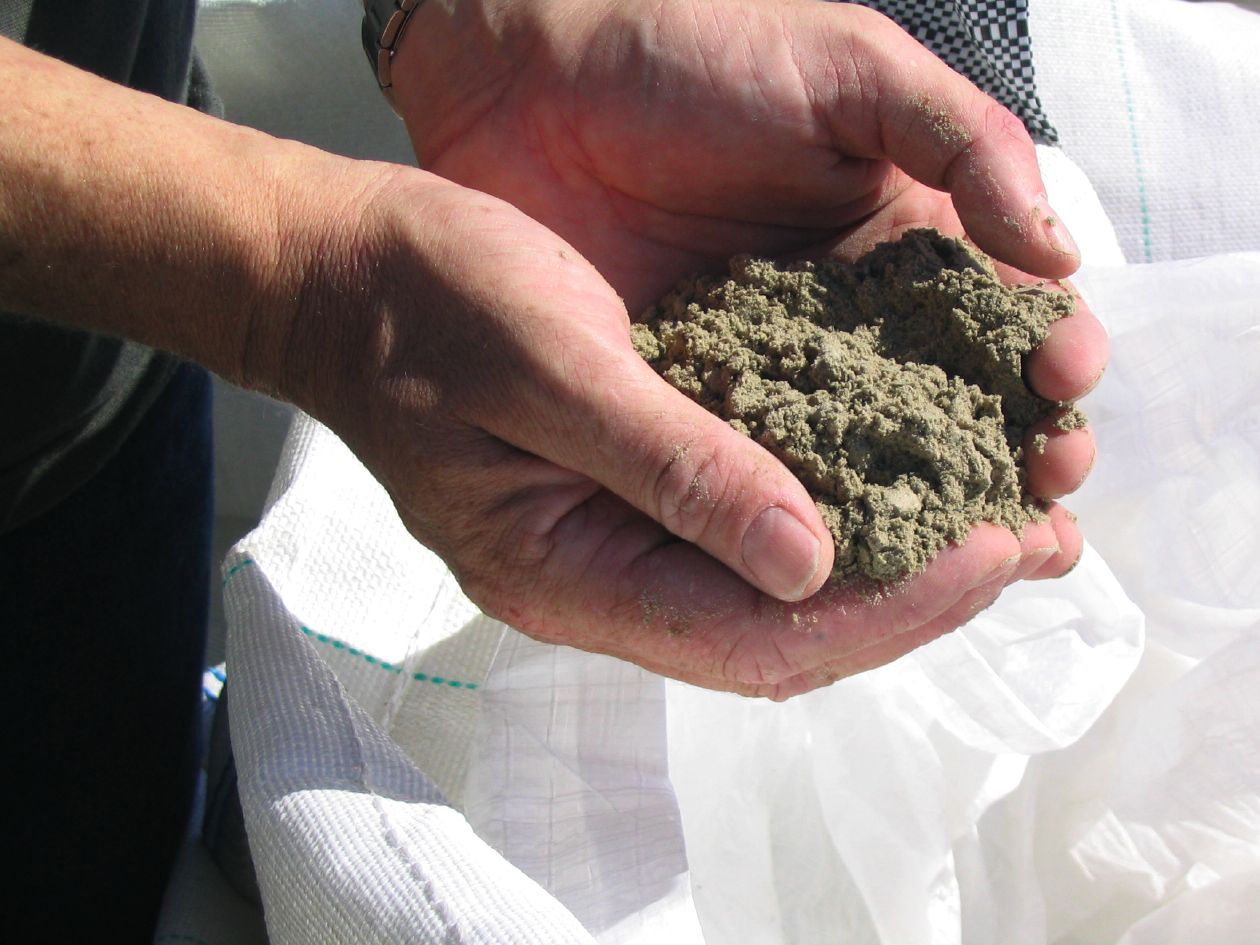
Large quantities of this material were
shipped to Caesarea in Israel, for example, in the last quarter of the first
century B.C. (Branton and Oleson, 1992; Hohlfelder et al., 2007), and we have also identified Baian pozzolana
at the smaller Roman harbour of Chersonesos in Crete (Brandon et al., 2005). In 2004 the team constructed an 8 m³
experimental pila in the harbour
of Brindisi using pozzolana from Baia and other appropriate materials. When
tested, the resulting concrete produced results very similar to those obtained
from ancient concrete (Hohlfelder et al., 2005; Oleson et al.,
2006). Since Baiae, Puteoli, and the
surrounding area were very likely the birthplace of structural hydraulic
concrete and its maritime applications, the region seemed an obvious choice for
sampling Roman maritime concrete structures.
Permission was granted by the Soprintendenza per i Beni Archeologici delle Province di Napoli e Caserta for the team to take cores on the long moles protecting the entrances to the commercial Portus Baianus and the military Portus Iulius, and from a series of large pilae in the Gulf of Pozzuoli halfway between the two harbours, now called Secca fumosa (“Smoking shoals”) because of the many submerged fumaroles in the area discharging hot water and gas (Scognamiglio, 2002; Miniero 2007). (Figure 3: map of coring sites)
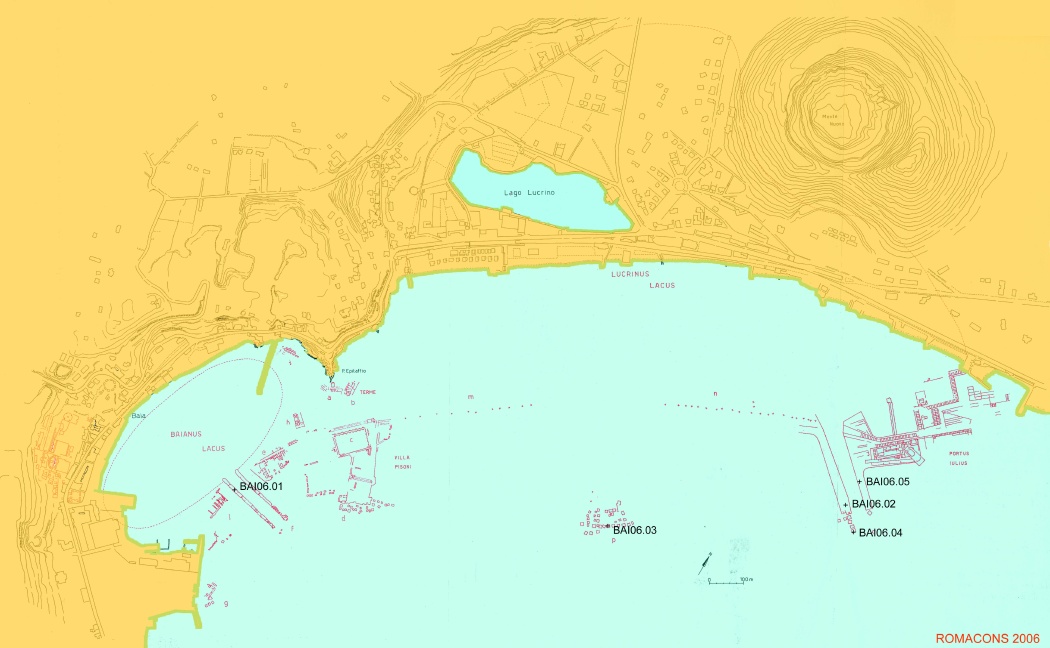
The upper surfaces of all these
structures once projected several metres above sea level, but isostatic change
of tectonic origin has left them at present around 3 to 4 m below sea level.
The harbour breakwater of ancient Puteoli is now inaccessible beneath the
modern breakwater. Marcus Agrippa constructed Portus Iulius in a rush during
the civil wars at the end of the Republic, around 37 B.C. (Suetonius, Life
of Augustus 16; Scherling, 1953). The
engineering challenges were enormous, and the achievement momentous enough that
both Vergil (Georgics 2.161-64)
and Pliny (Natural History
36.125) mention the harbour as one of the man-made wonders of Italy.
A fragment of
wood from the formwork in the pila off the port side mole of this harbour (as
one enters) yielded a C14 date of 50 B.C. (2060 Ī 40 B.P.; TO-13105). The date
of the harbour structures fronting Baiae is less well documented, but the town
was an important bathing and villa centre from the early-first century B.C., so
the moles and breakwater could be even earlier than those of Portus Iulius. The
function of the 28 pilae spread over an
area of 160 x 100 m at Secca Fumosa is not clear (Scognamiglio, 2002: 53-5),
but they may have protected an adjacent road on a now submerged shoreline, or
the Portus Iulius structures, by breaking the force of waves. Scognamiglio
suggests that they supported a lighthouse, or an alternate entrance to Portus Iulius.
In either case a date in the later first century B.C. or even later is likely.
A unique type of maritime construction evolved along with the development of hydraulic concrete in the Gulf of Pozzuoli. Pilae, large cubes or tall, square piers of concrete were cast on the seabed, their upper surface usually projecting above the waves. For the term pila see the glass souvenir flasks of the imperial period from Baiae illustrating the Puteoli breakwater with the inscription “pilae” (Ostrow, 1979); CIL X 1640, 1641, opus pilarum of the harbour at Puteoli; Seneca, Letters 77.1: in pilis Puteolorum; Livy, History 40.51.4: pilas pontis in Tiberi. One of the largest such structures known can be seen at nearby Nisida, with sides of 7.70, 9.02, 14.20, and 15.20 m and a height of over 9.5 m (Gianfrotta, 1996, 71). Such pilae were grouped together in a single line (sometimes connected by arches, as on the breakwater at Puteoli) or in two overlapping rows to form discontinuous breakwaters or sea defences for a shoreline or at the entrance to a harbour. Examples of this form of construction can be seen at Miseno, Baia, Secca Fumosa, Portus Iulius, Pozzuoli, and Nisida around the Gulf of Pozzuoli as well as other sites along the Italian coast, notably Cosa and Santa Liberata and further afield at Caesarea in Israel and Cherchel in Algeria. This manner of construction can be clearly seen in the ancient representations of the harbours of Puteoli and Baiae on a fresco at Stabiae (Figure 4: fresco representing harbour, Stabiae)
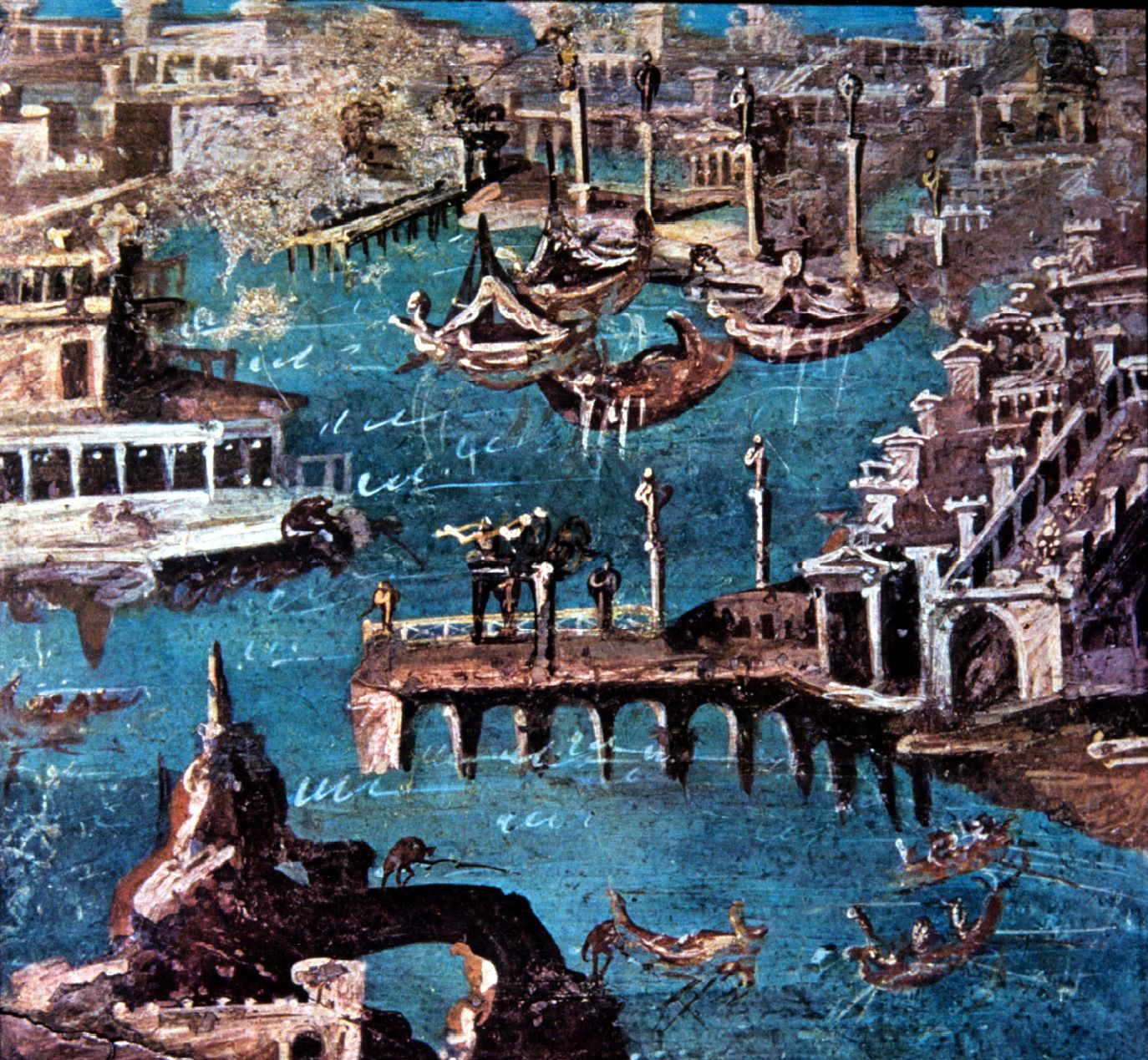
and a series of engraved glass souvenir vessels found at various sites around the empire (Blackmann 1982: fig. 5; Ostrow 1979) (Figure 5: glass engraving representing Puteoli harbour).
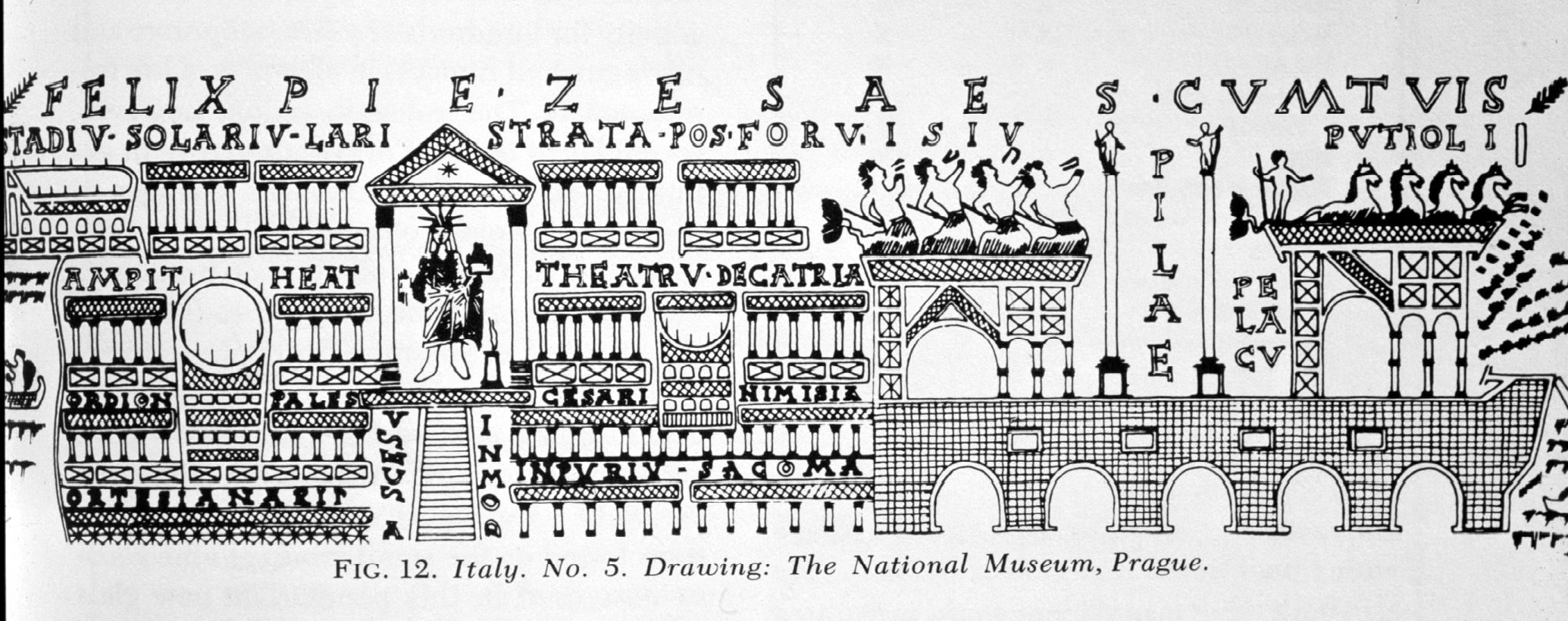
Roman designers took
advantage of the plastic nature of concrete to cast mooring stones into these
large masses, as on a number of the arched mole pilae at Pozzuoli as well as at Nisida and Misenum (Günter,
1903:272-3; Scognamiglio 2006: 70-73)). Continuous concrete moles, piers or
breakwaters were constructed as a line of abutting pilae, as at Portus Iulius and Portus Baianus.
It is puzzling
that such pilae sometimes had sides
finished with opus reticulatum (a
facing of small square blocks forming a net-like pattern) and opus
testaceum (brickwork), even when originally
underwater as at Secca Fumosa and Nisida (Gianfrotta, 1996:71; Scognamiglio,
2002: 54). This finish can also be seen on the submarine sides of the mole at
Ponza (Gianfrotta, 2002: 71-3, figs. 5, 7). It is likely that this facing,
invisible beneath the waves, was an attempt to protect the concrete core from
erosion. How the Romans laid masonry in regular patterns underwater is not
clear. Gianfrotta suggests that the blocks with such facing were cast within a
double walled cofferdam that had been pumped dry, but the practical
difficulties of achieving this at a depth of at least 6 m in the open sea with
the pumps available seem insuperable (Gianfrotta, 1996: 71). The pilae that formed breakwaters to harbour entrances,
protected shorelines or maritime villas were not individually or collectively
uniform. Even when clustered together they were of different sizes and often
with sides of varying dimensions. They were not even set out regularly, and
their spacing and orientation often varied. In contrast, fish ponds (closed and
semi-enclosed) were laid out geometrically, and even the pilae that formed the breakwater enclosure to the oyster
farm at Pozzuoli were relatively uniform in shape, spacing, orientation and
alignment. The reasons for this marked difference in quality between harbour
and sea defence structures and that of fish farms is not readily apparent.
ROMACONS 2006 Fieldwork in the
Gulf of Pozzuoli
Between the 6th and the
11th September 2006 five concrete cores were extracted from the
sunken remains of the harbour moles at Baia (BAI.2006.01), two pilae at Secca Fumosa (BAI.2006.03), and from the
submerged remains of Portus Iulius (BAI.2006.02, 04, 05) (see Figure 3 above). The
principle objective in taking these core samples was to add to the expanding
ROMACONS database of Roman maritime concrete, to enable us to make comparisons
between different sites and periods, and to gain knowledge of the development
of Roman hydraulic concrete.
The harbour of Baiae, or Portus Baianus, was built around a natural lagoon created by a long dormant volcanic crater now drowned beneath the harbour and marina of modern Baia. Two concrete moles define the entrance channel; the northern or starboard mole (on entering the channel from outside) is 209 m long, and the southern or port mole is 232 m long. The moles are approximately 9.5m wide and define a channel 32 m wide (Scognamiglio, 2002: 48). The core sample BAI.2006.01 was taken from the southern mole (Figure 6: plan of Lacus Baianus moles, Brandon after Scognamiglio 2002).
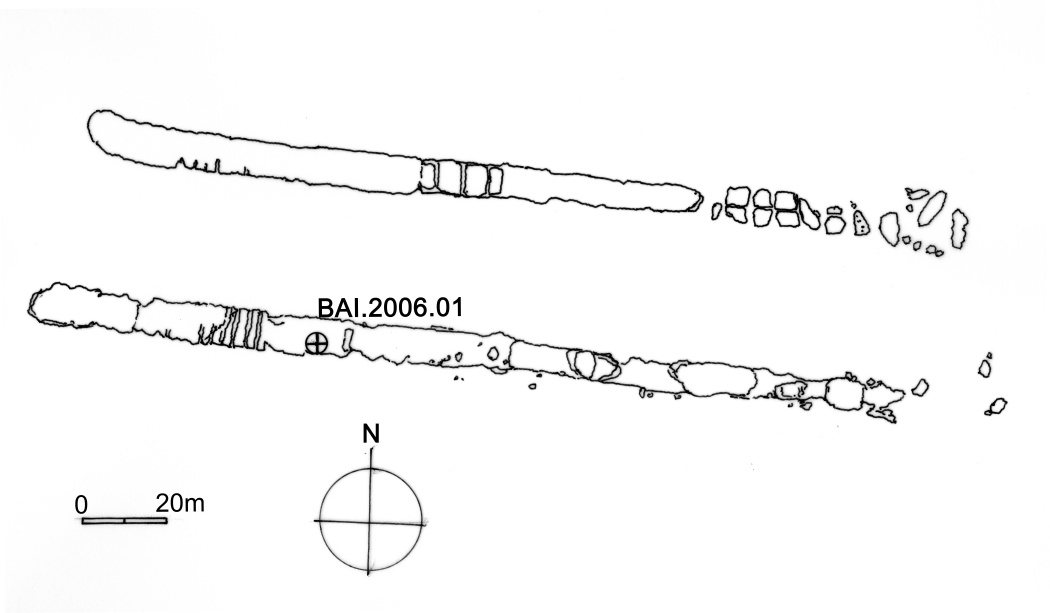
The concrete is at least 2.3 m thick, the length of the core recovered,
although the mole now stands only 1 m above the seabed.
At Secca Fumosa we took a 3 m core sample (BAI.2006.03) from one of the pila that had sides of 9.9, 10, 10.4 and 10.3 m and was over 5.7 m thick with the surface of the block 3.45 m beneath the waves (Figure 7: plan of Secca Fumosa, Brandon after Scognamiglio 2002).
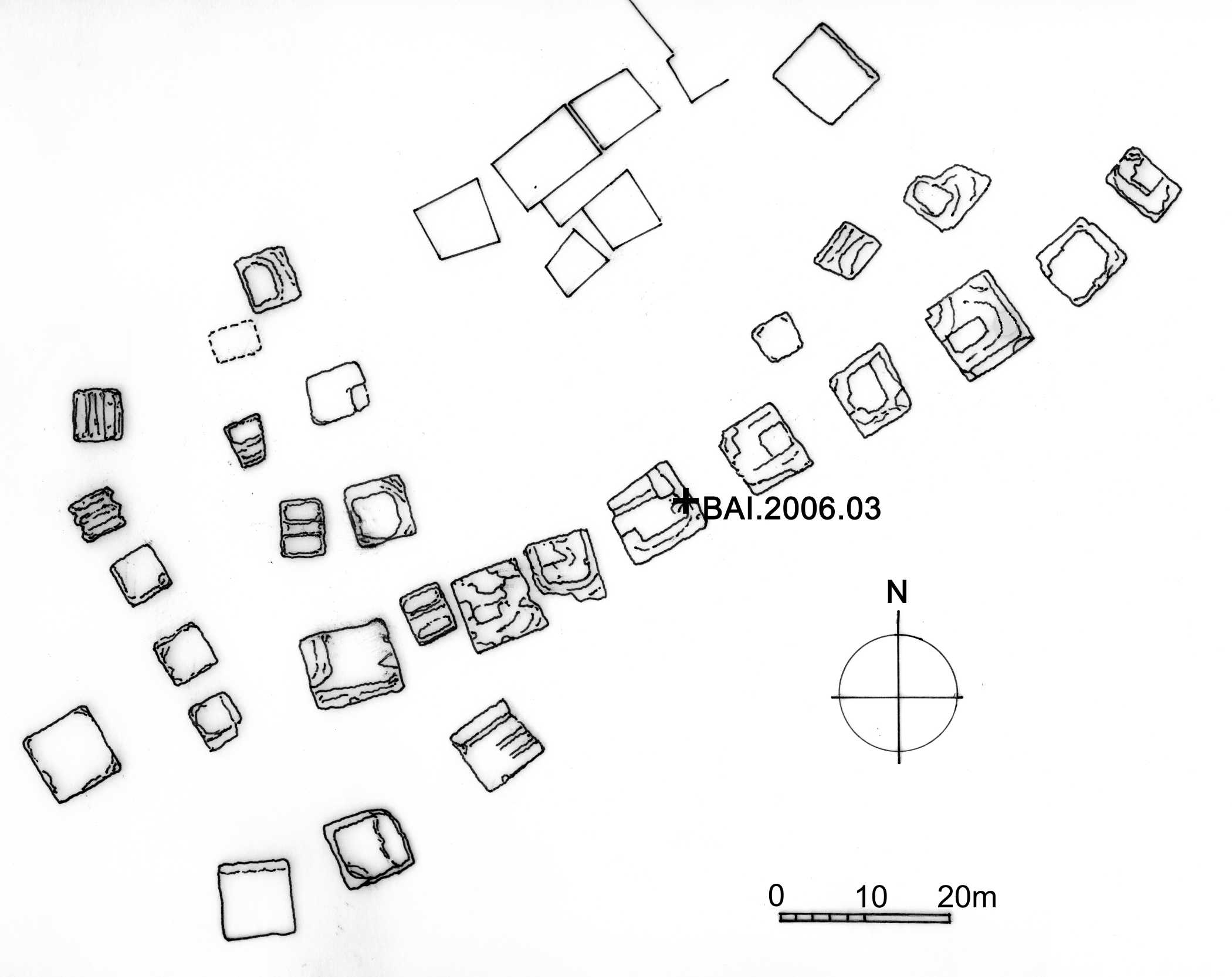
There was clear
evidence of an opus reticulatum
finish on the southern face at a depth of 6 m (Figure 8: opus reticulatum).
The moles
defining the entrance channel leading into the harbour basins of Portus Iulius
were similar in design to those at Baiae, although much larger. They are over
220 m long and between 20 and 30 m wide and channel width of 40 m (Figure 9:
plan of Portus Iulius moles, Brandon after Scognamiglio 2002). The ends of the
moles were defined by a series of large pilae, six on the port side (as one enters the harbour) and one on the
starboard. We sampled concrete from both entrance channel moles and the outer pila on the port side. The concrete was very eroded and
structure broken up; at the site of BAI.2006.02 on the port side mole it was
only 1.6 m thick and at BAI.2006.05 on the starboard side only 1.5 m thick. The
outer pila has sides of 10, 10
11.1 and 9.6 m and an overall height of over 6 m. A 1.5 m long sample,
BAI.2006.04, was extracted from the top, inset section of the pila at a depth of 3.8 m.
Description of the cores
BAI.2006.01 (06/09) Baia, port
side, southern entrance channel mole.
The top of the core was 5.1m below
sea-level, the depth of core hole was 2.3m, and the total length of core
recovered was 2.15m. (Figure 10: view of core).
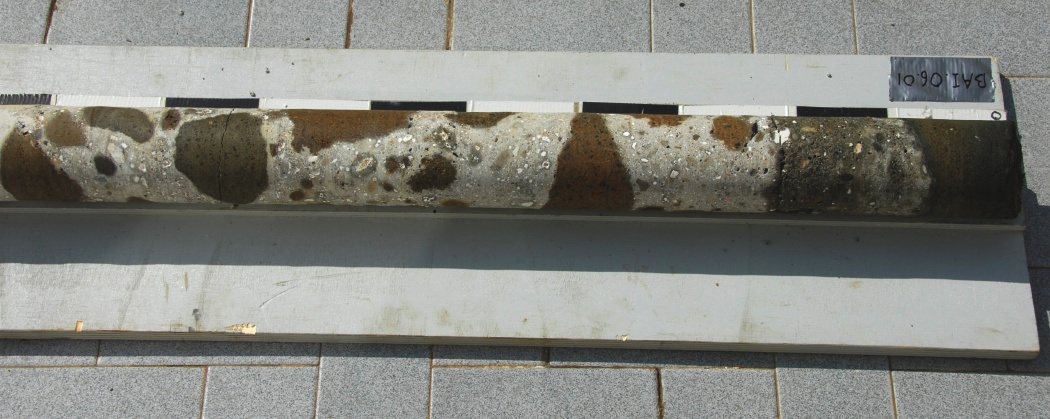
The aggregate is a local pale
yellow tuff. The mortar is very variable in consistency and quality and light
grey to black. The matrix is mainly fine and hard but includes many pebbles of
up to 10mm in diameter. The mortar in lower level of the core appears washed
out of the micro-aggregate. There are a number of large lime nodules of up to
50 mm diameter, and many voids.
BAI.2006.02 (07/09) Port side mole
of Portus Iulius.
The top of core was 3.9 m below
sea-level, the depth of core hole was1.6 m, and the total length of core
recovered was 1.2 m.
Very rough, porous, irregular
concrete with small aggregate of the local tuff. Very few small lime nodules,
and it appears that this sample has a low lime content.
BAI.2006.03 (08/09) Secca Fumosa pila.
The top of the core was 3.45 m
below sea-level, the depth of the core hole was 3.15 m, and the total length of
core recovered was 2.9 m. (Figure 11: view of cntral portion of the core).
Very uniform concrete with many
lime nodules , Generally resembles the cores we sampled from the experimental pila
we constructed in the harbour of Brindisi.
BAI.2006.04 (09/09) Outer pila on port side of entrance channel into Portus Iulius.
The top of the core was 3.8 m below
sea-level, the depth of the core hole was 3 m, and the total length of core
recovered was 1.63 m (the bottom fraction slipped out of the core catcher).
Very large, irregular aggregate of
the local tuff. There were occasional lime inclusions in the mortar.
BAI. 2006.05 (10/09) Starboard mole
of entrance channel into Portus Iulius.
The top of the core was 4 m below
sea-level, the depth of the core hole was 1.5 m, and the total length of core
recovered was 1.1 m0.
Large pieces of aggregate set in reasonably
good quality mortar, well mixed but appeared to be low on lime.
Analysis
The cores were
analysed at the research laboratories of Italcementi in Bergamo. A description
of the tests undertaken is included in Oleson et al 2004: 213-14. Preliminary findings suggest that the
concrete used at Portus Iulius was different from that found at Baia, Secca
Fumosa and all other sites that we have studied with the exception of the
concrete sampled at Area G at Caesarea in Israel, core CAE.2005.03. Our initial
conclusions after studying the Caesarea material was that the concrete had been
laid in rough conditions or that the mortar was too wet, resulting in
comparatively low levels of CaO and soluble SiO2 and a higher proportion of MgO
in the binding matrix (Hohlfelder et al 2007:414). Similar levels found in the Portus Iulius cores,
BAI.2006.02; 04 and 05, suggest that the builders used too much sea water in
the mix rather than being subjected to rough seas, since the chemical
composition was consistent across the harbour. Further, more detailed analysis
will hopefully more conclusive as to this significant variation in the
chemistry.
Acknowledgements
The directors of
ROMACONS are indebted to many people and institutions for their support and
assistance in helping this project become a reality. Dr. Stefano De Caro kindly
assisted with the request for a permit from Dr. Maria Luisa Nava,
Soprintendente for the region of Naples and Caserta, and Dr. Paola Miniero
graciously assisted our work at the site. Drs Luigi Cassar and Enrico
Borgarello of Italcementi have encouraged and aided our research since its
outset. We are also deeply grateful to their colleagues, Mr Dario Belotti, Mrs
Isabella Mazza, and Mr Massimo Borsa, for providing invaluable logistical
support and to Dr L. Bottalico, Dr R. Cucitore, Dr E. Gotti and Dr E. Vola for
their scientific expertise. We especially thank Dante Bartoli, Derek Klapecki
and Jonathan Cole for their assistance in the field.
References
Blackmann, D. J.
1982, Ancient Harbours in the Mediterranean, Part 1, International Journal
of Nautical Archaeology 11: 79-104.
Branton, G. and
J. P. Oleson 1992. The technology of King Herod’s harbour, in R. L. Vann (ed), Caesarea
Papers (JRA Suppl. 5) 49-67. Ann Arbor.
Brandon, C.,
Hohlfelder, R.L., Oleson, J.P., Stern, C. 2005. The Roman Maritime Concrete
Study (ROMACONS): the harbour of Chersonisos in Crete and its Italian
connection. Méditerranée 1.2, 25-9.
D’Arms, J. 1970,
Romans on the Bay of Naples, Cambridge MA.
Frederiksen, M.
W., 1959, Puteoli, in Real-Encyclopädie der klassischen
Altertumswissenschaft, XXIII.2, 2036-60.
Gazda, E. K.
1987. The port and fishery: description of extant remains and sequence of
construction, in McCann et al. The
Roman Port and Fishery of Cosa, 1987,
74-97. Princeton.
Gazda, E. K.,
2001, Cosa’s Contribution to the Study of Roman Hydraulic Concrete: An
Historiographic Commentary, in N. W. Goldman (ed.), Classical Studies in
Honor of Cleo Rickman Fitch, 145-77, New
York.
Gazda, E., 2008,
Cosa’s Hydraulic Concrete: Towards a revised Chronology, in R. L. Hohlfelder
(ed.), The Maritime World of Ancient Rome, Papers of a conference held at
the American Academy in Rome, 27-29
March 2003. Ann Arbor pp???
Gianfrotta, P.
A., 1996, Harbour Structures of the Augustan Age in Italy, in A. Raban and K.
G. Holum (eds), Caesarea Maritima: A Retrospective after Two Millennia, 65-76. Leiden.
Gianfrotta, P.
A., 2002, Ponza (puntualizzazioni maritime), Archeologia Subacquea III: 67-90.
Günter, R. T., 1903,
The Phlegraean Shore-Line (West of Posilipo) in Earth-Movements in the Bay of
Naples, The Geographical Journal 2 vol.
XXII: 269-289.
Hohlfelder, R.
L., Brandon, C., and Oleson, J. P., 2005, Building a Roman pila in the sea – experimental archaeology at
Brindisi, Italy, September 2004, The International Journal of
Nautical Archaeology 34.1: 123-27.
Hohlfelder, R.
L., Brandon, C., and Oleson, J. P., 2007, Constructing the Harbour of Caesarea
Palaestina, Israel: New Evidence From the ROMACONS Field Campaign of October
2005, The International Journal of Nautical Archaeology 36.2: 409-415.
Jackson, M,
Marra, F., Deocampe, D., Vella, A. Kosso, C., and Hay, R. 2007, Geological
observations of excavated sand (harenae fossiciae) used as fine aggregate in roman pozzolanic mortars, Journal
of Roman Archaeology 20: 25-53.
McCann, A.M., 2008,
Response to “Cosa’s Hydraulic Concrete: Towards a revised Chronology, by E.K.
Gazda,” in R. L. Hohlfelder (ed.), The Maritime World of Ancient Rome,
Papers of a conference held at the American Academy in Rome, 27-29 March 2003. Ann Arbor. pp???
Miniero, P.,
2007, Il parco sommerso di Baia: da sito archeologico ad area marina protetta, in
F. Gravina, ed., Communicare la memoria del Mediterraneo, Naples and
Aix-en-Provence, 197-204.
Oleson, J. P.,
Brandon, C., Cramer, S. M., Cucitore, R., Gotti, E., and Hohlfelder, R. L.,
2004, The ROMACONS Project: A Contribution to the Historican and Engineering
Analysis of the Hydrauilc Concrete in Roman Maritime Structures, IJNA 33.2: 199-229.
Oleson, J. P.,
Bottalico, L., Brandon, C., Cucitore, R., Gotti, E., and Hohlfelder, R. L.,
2006, Reproducing a Roman Maritime Structure with Vitruvian pozzolanic
concrete, JRA 19: 31-52.
Ostrow, S. E.
1979, The Topography of Puteoli and Baiae on the eight glass flasks, Puteoli 3, 77-140.
Painter, K.,
1975. Roman Flasks with Scenes from Baiae and Puteoli, The Journal of Glass
Studies 17, 54-67.
Scherling, K.
1953, Portus Iulius, in Real-Encyclopädie der klassischen
Altertumswissenschaft, 22.1: 408.
Scognamiglio, E.,
2002, Nuovi dati su Baia sommersa, Archeologia Subacquea 3: 47-55.
Scognamiglio, E.,
2006, Archeologia Subacquea a Miseno (Campi Flegrei), Archaeologia Maritima
Mediterranea 3:65-78.